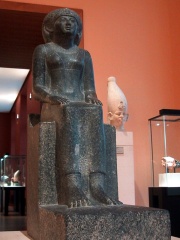POLITICIAN
Naram-Sin of Assyria
1900 BC - 1900 BC

 Naram-Sin of Assyria
Naram-Sin of Assyria
Naram-Sin, or Narām-Sîn or –Suen, inscribed in cuneiform on contemporary seal impressions as dna-ra-am-dEN.ZU, had been the "waklum" (ugula, Overseer) or "Išši’ak Aššur" (énsi da-šùr, Steward of Ashur) of the city-state Assur. Read more on Wikipedia
His biography is available in 17 different languages on Wikipedia. Naram-Sin of Assyria is the 14,996th most popular politician (down from 12,449th in 2024). (down from 3,144th in 2019)
Memorability Metrics
Page views of Naram-Sin of Assyria by language
Among POLITICIANS
Among politicians, Naram-Sin of Assyria ranks 14,996 out of 19,576. Before him are Eudokia Dekapolitissa, Hamoud bin Mohammed of Zanzibar, Eric Chu, Jakov Milatović, Anbasa ibn Suhaym al-Kalbi, and Francisco Antonino Vidal. After him are Zababa-shuma-iddin, Govind Ballabh Pant, Ernst Wetter, Sir William Temple, 1st Baronet, Suat Hayri Ürgüplü, and Károly Kárpáti.
Most Popular Politicians in Wikipedia
Go to all RankingsEudokia Dekapolitissa
801 - 801
HPI: 55.70
Rank: 14,997
Hamoud bin Mohammed of Zanzibar
1853 - 1902
HPI: 55.70
Rank: 14,998
Eric Chu
1961 - Present
HPI: 55.69
Rank: 14,999
Jakov Milatović
1986 - Present
HPI: 55.69
Rank: 15,000
Anbasa ibn Suhaym al-Kalbi
HPI: 55.69
Rank: 15,001
Francisco Antonino Vidal
1825 - 1889
HPI: 55.69
Rank: 15,002
Naram-Sin of Assyria
1900 BC - 1900 BC
HPI: 55.69
Rank: 15,003
Zababa-shuma-iddin
1200 BC - 1157 BC
HPI: 55.69
Rank: 15,004
Govind Ballabh Pant
1887 - 1961
HPI: 55.69
Rank: 15,005
Ernst Wetter
1877 - 1963
HPI: 55.69
Rank: 15,006
Sir William Temple, 1st Baronet
1628 - 1699
HPI: 55.69
Rank: 15,007
Suat Hayri Ürgüplü
1903 - 1981
HPI: 55.69
Rank: 15,008
Károly Kárpáti
1906 - 1996
HPI: 55.69
Rank: 15,009
Contemporaries
Among people born in 1900 BC, Naram-Sin of Assyria ranks 18. Before him are Da Ding, Neferuptah, Puzur-Ashur II, Damiq-ilishu, Enlil-bani, and Sithathoriunet. Among people deceased in 1900 BC, Naram-Sin of Assyria ranks 16. Before him are Ur-Ninurta, Nur-Adad, Khenemetneferhedjet I, Zabaia, Enlil-bani, and Sithathoriunet.
Others Born in 1900 BC
Go to all RankingsDa Ding
POLITICIAN
1900 BC - 1741 BC
HPI: 58.22
Rank: 12
Neferuptah
POLITICIAN
1900 BC - Present
HPI: 57.73
Rank: 13
Puzur-Ashur II
POLITICIAN
1900 BC - 1801 BC
HPI: 57.23
Rank: 14
Damiq-ilishu
POLITICIAN
1900 BC - 1800 BC
HPI: 56.68
Rank: 15
Enlil-bani
POLITICIAN
1900 BC - 1900 BC
HPI: 56.20
Rank: 16
Sithathoriunet
NOBLEMAN
1900 BC - 1900 BC
HPI: 56.14
Rank: 17
Naram-Sin of Assyria
POLITICIAN
1900 BC - 1900 BC
HPI: 55.69
Rank: 18
Others Deceased in 1900 BC
Go to all RankingsUr-Ninurta
POLITICIAN
2000 BC - 1900 BC
HPI: 59.21
Rank: 10
Nur-Adad
POLITICIAN
1900 BC - 1900 BC
HPI: 58.50
Rank: 11
Khenemetneferhedjet I
COMPANION
1950 BC - 1900 BC
HPI: 57.26
Rank: 12
Zabaia
RELIGIOUS FIGURE
HPI: 56.93
Rank: 13
Enlil-bani
POLITICIAN
1900 BC - 1900 BC
HPI: 56.20
Rank: 14
Sithathoriunet
NOBLEMAN
1900 BC - 1900 BC
HPI: 56.14
Rank: 15
Naram-Sin of Assyria
POLITICIAN
1900 BC - 1900 BC
HPI: 55.69
Rank: 16






















